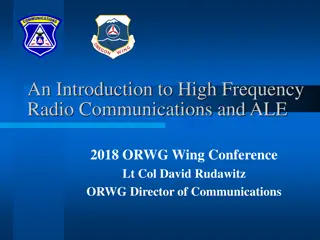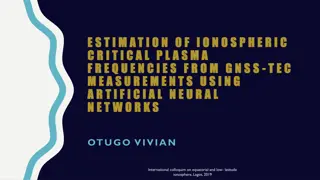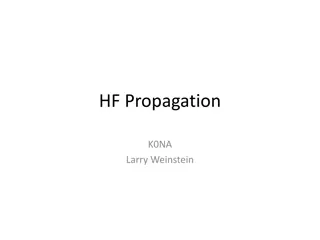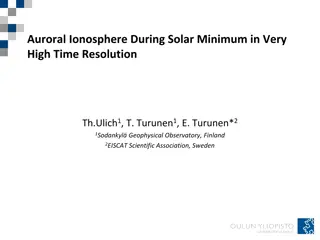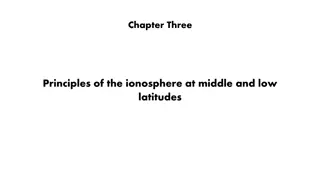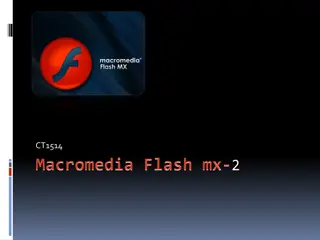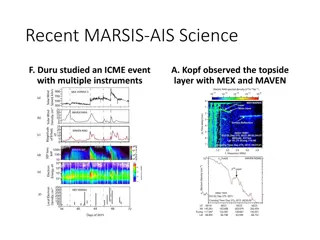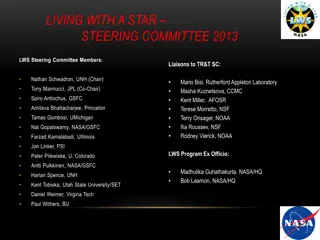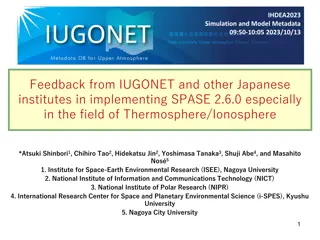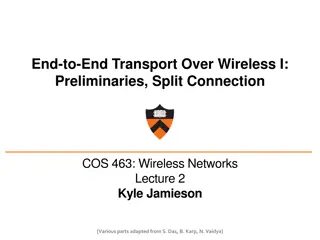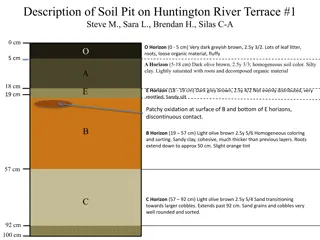Understanding the Layers of the Ionosphere
Explore the layers of the ionosphere including the D, E, Es, and F layers and how they impact radio wave propagation. Discover how solar activity affects ionization levels and skip distances, offering insights into long-distance communication potential. Learn about the influence of solar radiation on each layer and the changes that occur from day to night. Unravel the connection between solar-terrestrial data and its relationship to the ionosphere layers.
Download Presentation

Please find below an Image/Link to download the presentation.
The content on the website is provided AS IS for your information and personal use only. It may not be sold, licensed, or shared on other websites without obtaining consent from the author. Download presentation by click this link. If you encounter any issues during the download, it is possible that the publisher has removed the file from their server.
E N D
Presentation Transcript
Layers of Ionosphere Night Layers Day Layers Each of the layers has different ways that they effect your radio signal and that changes as you move thru day to night.
Layers of Ionosphere D Layer is the inner most layer at 48 to 90 km above us. It attenuates MF and HF frequencies below 10 MHz. What ionizes this layer is good old sun light and during solar flares hard X-rays add to the ionization of this layer. Generally the effects on the D layer peak around noon and decrease at night reducing the thickness of this layer, but it doesn t completely disappear due to cosmic rays. This is why there are distant AM broadcast stations that you can hear at night, but disappear during the day. But during solar proton events ionization can reach very high levels in the high and solar latitudes, that what is called a Polar Cap Absorption (PCA) that radio signals passing this area are absorbed. These events last less than 24 to 48 hours.
Layers of Ionosphere E Layer is the middle layer that is 90 to 150 km above us. This layer is ionized by soft X-rays and far ultraviolet solar radiation. The E Layer reflects radio waves that are 10 MHz and lower, it also contributes some to the absorption of radio waves 50 MHz and higher. At night the E Layer weakens due to lack of the solar radiation. And at night because of this lack of ionization the height of the layer increases causing an increase of the range of that radio waves are that reflected. So you go from being a short range local band to a DX band.
Layers of ionosphere Es layer or sporadic E layer is small thin clouds of intense ionization, which can support reflection of radio wave frequently up to 50 MHz and sometimes up to 450 MHz. Sporadic E events can last only a few minutes or up to hours. This allows the lucky ham to work some long distance communication. Skip distances are generally around 1640 km, but skip distances can range from 900 to 2500 km on a single hop. And multi-hop propagation of over 3500 km, with some time contact of up to 15000 km. These generally happen during the months of June and July.
Layers of Ionosphere F Layer is the upper most of the Ionosphere, it extends from 150 to 500 km above us. During the day the F layer is made up of the F2 layer which is there day and night, the F1 layer is only there day light. Because the F2 layer is with us 24 hours a day, it is responsible for most of the skywave propagation of radio waves.
Solar-Terrestrial Data What do these numbers mean and how do they relate to the Ionosphere and the layers in it? The top line is the date and time in Universal Time or UT. This is the time for which this data is current. You can find these information panel in a number of amateur radio sites such as QRZ and others. Most web sites update this information as you log in their web site, if you are parked on a web site for a significant amount of of time you may want to refresh this data periodically, so that you have the current data. I have noticed that from the time I turn on my Geochron during the pre net till the time I give my report on the regular net the readings change, sometime greatly.
Solar-Terrestial Data SFI or Solar Flux Index is the amount of Solar radio noise measured at 2800 MHz and is updated daily. The SFI gives us an Idea of how will the ionospheric F layer can support radio communication on HF, And more especially on 20 meters through 10 meters. (70 = poor / 160 = good / 280 = fabulous) SN or Sunspot number is a calculation that is roughly 10 X the number of sunspot groups facing us + the number of individual sunspots facing us, and is updated daily. The SN typically follows the SFI, and offers another indicator of F layer ionization. ( 2 = poor / 90 = good / 220 fabulous ) Ap index is the a daily average long- term stability of Earth s magnetic field, the subscript P means planetary, or average from several location around the earth. (4 = calm / 40 = minor storm / 80 = severe) Kp index is the daily average short- Term stability of Earth s magnetic field, the subscript P means planetary, or averaged from several location around the earth. ( 1 = calm / 5 = minor storm / 7 = severe )
Solar-Terrestrial Data X-Rays emissions most heavily impact the ionospheric D-layer, such that the stronger the radiation, the lower the ability of the radio waves to propagate by skywave refraction. The intensity of X-ray radiation striking the atmosphere, ranging from A0.0 to X9.9, is defined by a class (A, B, C, M, and X ), followed by a logarithmic quanity ( 0.0 to 9.9 ) that defines the intensity within the class, updated eights a day. ( A1.1 = good / C5.0 = moderate / X2.3 = severe ) 304A Angstroms is the relative strength of total solar radiation in the UV (ultraviolet) range, originating from the ionized Helium in the Sun s photosphere, and often follows the SFI value. The designation following the 304A value ( @ EVE, @ SOHO, @ SEM ) indicates the instrument used to take the measurement, and the value is updated hourly. ( 80 = poor / 150 = good / 240 = fabulous) Proton Flux ( Ptn Flx ) is the density of protons in the solar wind, the higher the value the greater the impact on the E layer. Updated hourly. (0.10 = good / 2.0 = moderate / 20.0 = heavy ) Electron Flux ( Elc Elx ) is the density of charged electrons in the solar wind, the higher the value, the greater the impact on the E layer. Updated hourly ( <1000 = little impact / >1000 = heary impact )
Solar-Terrestrial Data Aurora Possiblity ( New)Relative strength in the GW ( 5 to 200) of the ionospheric F layer, affecting DX over polar regions, such that the stronger the ionization, the greater chance of aurora at lower latitudes. ( Old scale ), values range from 0 to 10++ over the normalizeation factor, such that n < 2.0 shows a high confidence and n > 2.0 shows a low confidence) Updated every 15 minutes ( 1/n =1.99 : weak 6/n = 0.8 : moderate) (New scale used by NOA, Old scale is still used by many others) Bz (B sub z) Interplanetary magnetic field vector ( strength and direction ) perpendicular to the plane of Earth s orbit, with positive values enhancing Earth s magnetic field and negative values canceling it. Updated hourly. ( 20 = good / 2 = OK / -2 not OK / -20 disruptive) SW (Solar Wind) Average speed of solar wind particles in km/s, with figures greater than about 500 impacting HF communication. Updated hourly. (100 = good / 500 = moderate / 700 = disruptive) Aur Lat (Aurora Latitude) Lowest estimated latitude impacted by an aurora, in degrees N Latitude. ( 70 = weak / 60 = moderate / 50 = strong )
HF Band Conditions The HF Conditions panel shows the PREDICTED conditions of a segment of bands during the day or night. But the only true test of whether a band is open is to get on it as said by Jeff KI4FSZ
HF Band Conditions Sig Noise Lvl (Signal Noise Level ) The signal noise level is an logarithmic measurement (in 6 dB increments, like you use on an S meter) of The noise generated as a result of the solar wind, compared with the noise floor. The greater the disturbance in the solar wind, mostly due to interaction with the Earth s field, The higher the S value, updated every 30 min Geomag Field (Geomagnetic Field) Relative labels of the Earth s magnetic field activity, reflecting the Kp index. Labels include INACTIVE, VR QUIET, UNSETTLD, ACTIVE, MIN STORM, MAJ STORM, SEV STORM, AND EX STORM, in the Order of disruptive impact on radio propagation, updated every three hours. Solar Flare Prb (Solar Flare Probability) A solar flare is a sudden burst of radiation, consisting of electrons, ions and high eletro- magnetic radiation, over the surface of the Sun. This huge emis- Sion can reach Earth and strengthen ionization of the D Layer, absorbing radio signal and disrupting HF communication. The chance of a flare erupting on the solar surface gives you an idea of how much you HF communication migh get disturbed in the next 24 hours by a solar storm. Value is updated hourly. MUS US Boulder (Maximum Usable Frequency) From on of 11 locations world wide, the highest frequency that cam be reliably used for communication by skywave propagation. Listed in MHz, updated every 15 minutes.
VHF Band Conditions The panel above show the VHF band conditions. This panel shows if there are Sporadic E band conditions on the 6 meter, 4 meter and the 2 meter bands in Europe, and on the 2 meter in North America.
VHF Band Conditions EME Deg (Earth-Moon-Earth Degradations) Measurement of the best Earth-Moon-Earth (Moonbounce) propagation Path anttenuation, displayed as Very Poor ((high attenuation), Poor, Fair (medium attenuation), Good, and Excellent (little attenuation), these are updated every 30 minutes. MUF (Maximum Usable Frequency), Es This MUF is relative to Sporadic E, is the highest frequency that can be reliably used for skywave communication by Sporadic E propagation. In this column the banner displays the MUF As a colored bar for each VHF band: 6 meters = blue, 4 meters = green, 2 meters Europe = yellow, 2 meter North America = red and gray for no activity, this is updated every 30 minutes. The SEASON BREAK label indicates that Sporadic E label indicates the Sporadic E is not normally active this time of year.
VHF Band Conditions MS ( Meteor Scatter ) The Meteor Scatter activity bar show relative meteor scatter activity for the times of day listed in UTC, using the MIN MAX color scale below it. This bar displays color for the active time, and gray for no activity, this is updated every 15 minutes.
Sources https://noji.com/hamradio/pdf-ppt/noji/Noji-Article-Band-Conditions-Banner.pdf www.hamqsl.com/solar2.html#usingdata https://spaceweather.com/ https://www.qrz.com/ https://www.swpc.noaa.gov/content/space-weather-glossary https://en.wikipedia.org/wiki/Ionosphere
Additional Reading On Subject Here to There: Radio Wave Propagation ( 1st edition ) Published by ARRL The ARRL Operating Manual For Radio Amateurs Published by ARRL The ARRL Handbook For Radio Communications Published by ARRL








